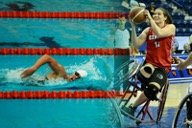Together, Apart or Somewhere in Between: Considerations for Managing Para Sport
By Darda Sales. The author is currently a PhD candidate at Western University in London, Ontario.
As a four-time Paralympian, coach, and PhD candidate, I have heard the statement ‘Sport is sport’ numerous times and I agree that the goals of sport are consistent for able-bodied and para athletes: enjoyment, competition, pushing oneself to be the best one can be at their chosen activity. However, to ensure sport and physical activity meets its intended outcomes and is beneficial to all participants, sport managers working in para sport need to be aware of the discussion surrounding segregation and integration.
Segregated Para Sport Opportunities:
Segregated sporting opportunities allow para athletes to be themselves without the impact of ableist views weighing in on them. In my experience, segregation provides opportunities to be with only those with similar experiences, and these segregated environments allow para athletes to build their self-confidence and skills in an environment set up to meet their particular needs. It helps them connect with others who share similar background experiences. It also allows para athletes to make mistakes, to stumble and fail in an accepting environment, with less concern of judgement or scrutiny. Intended or not, a lot of pressure can be placed on para athletes if they feel that they are being expected to live up to the same standards as able-bodied athletes (Wolbring, 2012). A segregated environment can relieve that pressure and allow para athletes to develop their own skills, at their own pace, and in their own way.
Integrated Para Sport Opportunities:
Alternatively, integration is the intermixing of para and able-bodied athletes (Howe, 2007). In Canada, para sport has seen an increase in training and competitive opportunities when sports such as swimming and athletics began to be integrated in the 1990s. Integration allows for increased access to educated coaches and well-equipped facilities. It allows para athletes to challenge themselves alongside other athletes who are chasing similar goals and dreams, whether those other athletes have impairments or not.
Note of Caution: simply allowing para athletes into your program is not true integration (Berry, 1996). Thought and consideration needs to be given to include para athletes in a meaningful way into programs offered. Having a para athlete in a program continually struggling to keep up with their non-impaired counterparts or fitting into a prescribed program or sitting on the sidelines is not true integration (Berry, 1996).
The integration of para athletes needs to receive consideration and thought as to what works best for the functional level of the para athlete, where they are now, where they have the potential to get to, and a set plan on how to help them reach their full potential. Swimming Canada is an example of an organization that continues to put time, effort and resources into improving the integration of para athletes within their programming.
A Hybrid Approach:
A fitness center with both a general and a women’s only workout room is a comparable idea to the optimal training environment for para athletes. The women’s only room allows women to exercise in a segregated environment with others with similar experiences. Women’s only rooms tend to have smaller equipment to fit the smaller size of some women, and provides them with a comfortable, judgement-free environment. The general room, in which people of all shapes, sizes, genders, and experiences exercise, tends to have heavier weights and more equipment. Women are welcome to train in whichever environment works best for their personal comfort and training needs. Sporting opportunities for para athletes need to take on a similar thought process as not one environment, segregated or integrated, will always be the best fit for all para athletes.
Having experienced both segregated and integrated training and competition opportunities as a para athlete, I fully believe that there is a time and place for both environments. If sport managers recognize and accommodate this need, it can result in long term para athlete engagement and success within their programs.


